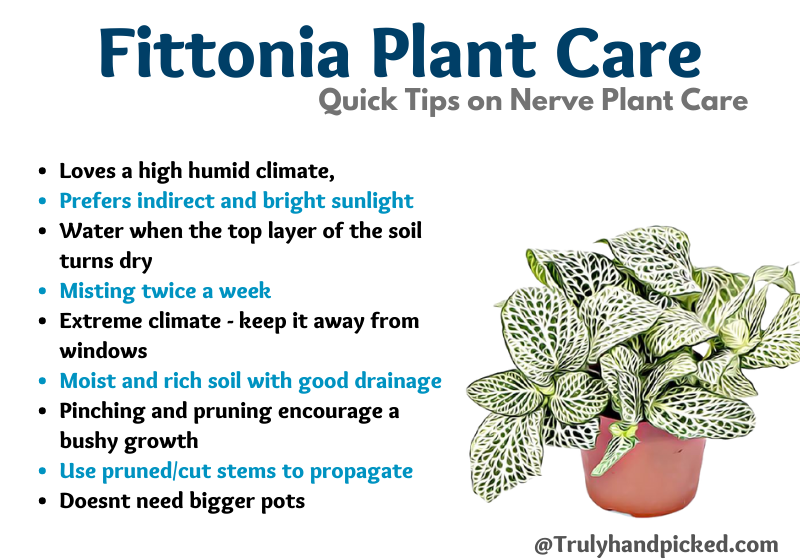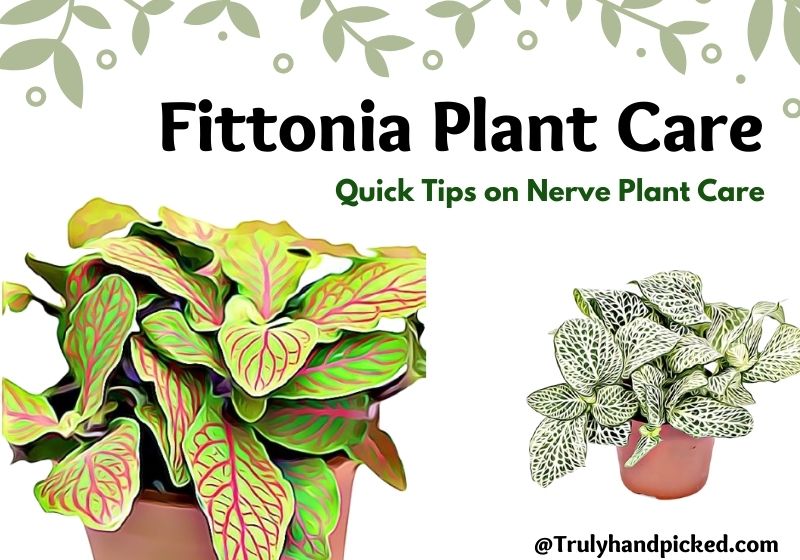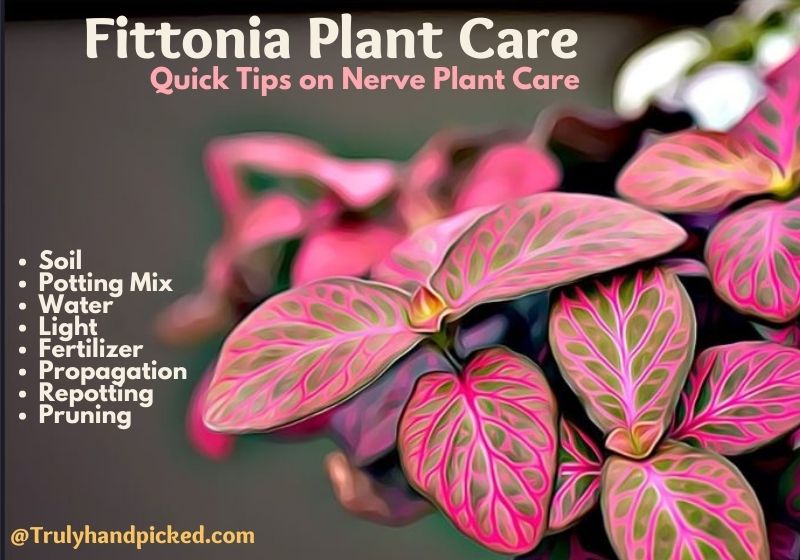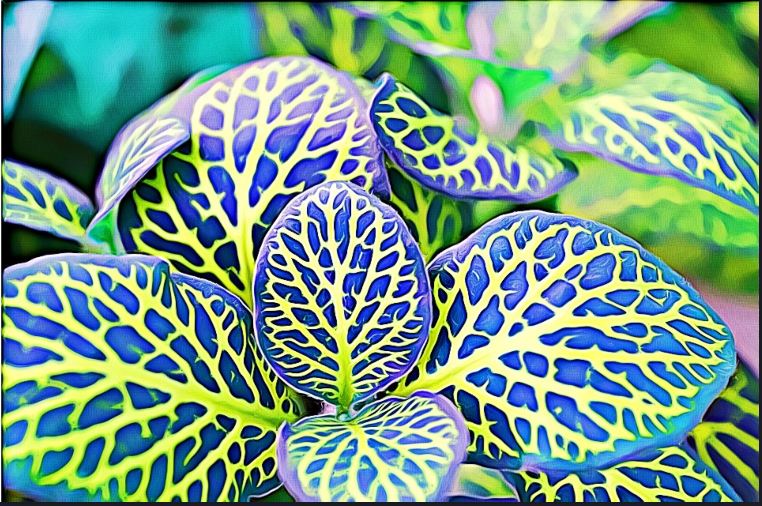What’s inside: Fittonia plant care, how to make nerve plant bushy, pruning, and propagation techniques to make it fuller. Also, quick tips on stripes forever plant care, soil, water, and lighting requirements to promote better growth.
Fittonia or nerve plant is a beautiful-looking flowering plant that belongs to the genus of the Acanthus family(Acanthaceae).
Despite being native to the tropical rainforest of South Africa, Fittonia is very easy to take care of, if you know the proper procedure. Here is a simple tutorial for how to take care of Fittonia at home like an expert gardener-
Fittonia Plant Care: Quick Overview
- Fittonia loves a highly humid climate, so if your region or climate is highly humid it results in better and faster growth
- Since tropical needs indirect and bright sunlight, having said never place it under direct sunlight
- Can also grow in low light and moderate watering
- Watering once in a while or checking for the top layer of the soil to turn dry
- Misting has to be done at least twice a week, to keep the leaves fresh and aid in healthy foliage growth
- If the climate is extremely hot windy or dry and cold, keep it away from windows
- Moist soil and rich soil with good drainage are the keys to keeping nerve plants healthy and free from wilting, curling, and turning crispy.
- Pinching off the buds and tips will encourage bushy growth for your Fittonias
- Regular pruning is not just for its pleasing bushy look, but from cuttings, you can start a new plant.
- Nerve plants are not toxic to your dog and cat
- Easy to propagate in water or soil with a warm climate, good humidity, and indirect bright light. Retaining moisture with good drainage gives better results in the case of soil propagation.
How to Make Fittonia/ Nerve Plant Bushy

1. Pinch back the tips of the plant: Using your fingers or a pair of sharp, clean scissors, pinch back the tips of the stems on your fittonia plant. This will encourage new growth and make the plant bushier.
2. Trim leggy stems: If you notice any long, leggy stems on your fittonia plant, trim them back to just above a leaf node. This will promote branching and create a fuller, more compact plant.
3. Provide proper lighting: Fittonia plants prefer bright, indirect light. If your plant is not getting enough light, it may become leggy and sparse. Move it to a brighter location or provide supplemental lighting with a grow light.
4. Keep the soil consistently moist: Fittonia plants like to be kept evenly moist, so make sure to water regularly and keep the soil from drying out completely. Dry soil can cause the plant to wilt and lose leaves, making it look sparse.
5. Fertilize regularly: To encourage healthy growth and a bushy appearance, fertilize your fittonia plant every 4-6 weeks during the growing season with a balanced fertilizer.
6. Consider propagation: If your fittonia plant is not responding to the above steps, consider propagating it by taking stem cuttings and starting new plants. This can help you create a fuller, bushier plant over time.
Top 5 Types of Fittonia/ Nerve Plants
- Fortissimo: One of the most popular Fittonia varieties with large bushy foliage. Moreover, the deep green leaves of this plant are embellished with both pink and red veins, which make them more attractive to look at.
- Pink Star: This type has small and wavy leaves with broad veins. The pink-colored veins give this Fittonia type a unique look from its other equivalents.
- White Anne: One of the most prevalent types of Fittonia that grows medium-size leaves with curly edges. The gorgeous white hue on deep green leaves makes this plant livelier to resemble.
- Juanita: This is another exclusive genus of Fittonia that grows a very exceptional type of leaves. Leaves of this Fittonia plant display vibrant red veins over the deep green background with a delightful pinkish hue.
- Red Vein: Red vein Fittonia looks supremely eye-catchy when placed in a room due to the bold red veins of leaves over a dark-green surface. This plant needs a larger pot to spread its roots and thrive properly.
Fittonia Plant Varieties
Also, known as Red Nerve Plant – Mosaic Plant – Silver Nerve Plant – Lace Leaf
- Red Anne
- Black Star
- White Brocade
- White Snow
- Mini Superba
- Titanic
- Mini Red Vein
- Leather Leaf
- Josan
- Stripes forever
- Daisy
Fittonia Overview for Plant Enthusiasts
- Fittonia is an ornamental foliage plant and is also known as a nerve plant or mosaic plant, etc.
- Albivenis and its cultivars are the common types of Fittonia that are mostly grown
- They grow like evergreen perennials and these dense ground cover plants can grow up to 10-15cm
- This plant grows white to off-white colored flowers after a certain while
- Leaves have white to deep pink accented veins
- And they have fuzz covering over their stems
Benefits of Fittonia: Why grow nerve plants?
- These plants are air purifiers and thus bring the carbon dioxide levels down in your room
- They make your house climate healthier by controlling nitrogen dioxide level
- Also, Fittonia helps to reduce benzene or benzol, toluene from the air as well and acts as a purifier.
- As it works as an air cleanser, Fittonia also increases the humidity around the plant
- The eye-catchy look of this plant adds a decorative touch and gives your room a whole new glance.
- The leaves and stems of Fittonia have medical importance. So, you can use them as the main ingredient in some ayurvedic treatments for headaches, muscle pain, toothache, etc.
- Fittonia can make a great gift of itself, as it looks catchy, easy to place, and simple to take care of as well.
How to Care for Fittonia/ Nerve Plant:

Fittonia is native to South Africa, especially from Peru, and thus this type of plant needs special care to thrive naturally. You have to take care of every single section of planting very attentively. Here is an easy guideline for you in this regard-
Soil and Potting Mix:
Like other tropical plants, Fittonia grows perfectly with wet yet well-drained soil types. Make sure that the moist quality stays in the soil but doesn’t get damp. Sow Fittonia in a pot, which has a perfect drainage system and never lets the water stay in the soil for long, otherwise, it may rot or damage the root badly. Prepare the usual potting with the base of peat moss to give your Fittonia plant perfect growth.
Lighting and Placement:
No matter whether you plant your Fittonia indoors or outdoor of your house, make sure it gets bright light through a shady climate.
In tropical areas, the Fittonia genus gets its light indirectly through heavy forests. So, try to put your plant in a place in the house, where it can steal the light indirectly rather than direct heavy sunlight.
Indoor Plants Lighting Care – Learn more about the bright indirect lighting needs of plants.
How Often to Water:
Tropical plants need constant water to bring with them a good drainage system. They can’t grow in dry soil, so water your Fittonia plant after a few whiles, especially when 25% of the top of the soil seems dry.
And make sure you don’t make the soil soggy by watering them too often. Fortunately, the leaves of Fittonia plants seem limp with a lack of water, hence, they can help you in this case by giving a clear hint of when to water them.

Temperature:
Fittonia wants a normal room temperature. So, try to keep the in-between 65 degrees to 80 degrees, especially during the thriving time. Try to keep the temperature natural as much as you can. Fittonia can’t stand the direct cold or hot airflow from artificial devices. The normal home humidity level is tolerable for nerve plants, but it grows more healthily in heavy humidity levels.
Use Mild Fertilizers:
As Fittonia is an evergreen herbaceous perennial type plant, it doesn’t require higher fertilizer for healthy growth. A standard type of potting soil with a peat moss base is enough to provide the root with proper nutrition. Try to use 5-5-5 fertilizer that is diluted to half strength for the perfect Fittonia fertilization. Make a mix of compost, peat moss, and perlite with the proportions of 60/30/10 for the best result.
How to Propagate & Repot Fittonia
You can easily prune and propagate this houseplant to control its over-bushy glance and give them enough space to thrive again. Let’s check out this process in an easy step-by-step method-
- Bring a sharp pruner and find out the knaggy Fittonia plant from your collection first
- Take an empty planting pot and prepare the potting mix inside it by mixing compost and peat moss with the right proportion
- Now, snip the larger stems of your plant with a pruner and prune them carefully by removing the lover leaves from the cuttings
- Then, just sow the stem straight back into the soil and repeat the process and propagate as many as you want
- Finally, water the newly planted Fittonia and add some more potting mix over the top to secure the plantation perfectly.
You may also be interested in quick tips on peace lily plant care.
How to Propagate Fittonia or Nerve Plant in Water
- Just like propagating in soil, select a healthy shoot with a leggy stem
- Remove a few leaves from the bottom part of the mosaic plant’s cutting
- Take a glass jar or bowl for propagation as watching through the process of rooting is cool
- Fill with normal tap water (unless it’s hard)
- Now place the cutting with the bottom few inches remains immersed in water
- If the water turns cloudy or algae formation is a seed, remove and refill fresh water
- Place the jar/bowl in a warm place with indirect bright sunlight
- Once you see new shoots and healthy roots, you can transplant it to a new pot with a potting mix with good drainage.
Recap on How to Make Fittonia Bushy
- To make your nerve plants bushy, you must give them enough room to thrive
- So, snip off the unhealthy stems by pruning them clearly
- Try to repot your over-grown Fittonia in a larger pot every time it overflows
- After trimming properly, water your Fittonia regularly and make sure the water drains well
- Consistent trimming is the key to making your nerve plant bushy.

Troubleshooting Fittonia: Frequently Asked
Why My Nerve Plant is Drooping?
If you keep your Fittonia dry for long, it will start drooping. Try to water your nerve plant once the top few inches of the topsoil surface seems dry. Also, an improper climate could drive your Fittonia to droop. So, check out for low humidity, direct sunlight, or heavy temperature as well.
Why My Nerve Plant is Crispy?
As mentioned above, lack of water is a reason that makes your nerve plant go crispy. The roots of Fittonia plants need to be moist constantly to maintain their striking foliage. So, if your plant seems crisp, water them consistently and look for the proper drainage system too.
How to Revive My Dying Fittonia?
Watering is the best way to revive a dying Fittonia plant. So, if you find your nerve plant is dying, water it immediately and thoroughly. Once the potting mix is wet entirely, wait for some time to let it recover. Sometimes, over-bushy nerve plants also die due to the lack of thriving space. Hence check for that possibility too.
What Pot size to promote growth in fittonia
Fittonia plants are slow-growing in nature and doest need too much fertilizer. Also, they don’t have a large root system, so you don’t need bigger pots. fertilizer at half dilution or nature fertilizers once every two months is happy enough for these never plants.
What kind of soil does Fittonia prefer?
A: Fittonia prefers well-draining soil that is rich in organic matter. A mix of peat moss, perlite, and vermiculite works well for this plant.
How often should I water my Fittonia plant?
Fittonia plants like to be kept evenly moist, so water them regularly and avoid letting the soil dry out completely. Water when the top inch of soil feels dry to the touch.
Can I propagate Fittonia by stem cuttings?
Yes, Fittonia can be easily propagated by taking stem cuttings and rooting them in water or moist potting soil. This is a great way to make your plant bushier over time.
How do I make my Fittonia plant bushy?
To make your Fittonia plant bushy, pinch back the tips of the stems, trim any leggy stems, and provide proper lighting and watering. Fertilizing regularly and considering propagation can also help encourage bushier growth.
What kind of lighting does Fittonia need?
Fittonia plants prefer bright, indirect light. Avoid direct sunlight, as this can scorch the leaves.
How often should I fertilize my Fittonia plant?
Fertilize your Fittonia plant every 4-6 weeks during the growing season with a balanced fertilizer. This will provide the nutrients it needs to grow bushier and healthier.







